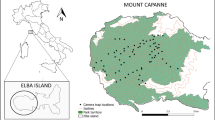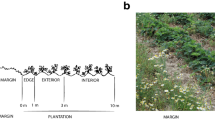Abstract
The sustainable management of vole populations to reduce crop damage requires a reliable estimation of rodent density. The present study was conducted in 2011 in Asturias (NW, Spain) and aimed at developing a method for estimating the density of the water vole Arvicola terrestris cantabriae and the Lusitanian pine vole Microtus lusitanicus in apple orchards based on their presence signs. Previously, as A. t. cantabriae and the Iberian mole Talpa occidentalis occur simultaneously in the same habitats, we had to determine if earth mounds caused by these two species may be accurately differentiated. The results showed that presence signs may be used to discriminate the occurrence of A. t. cantabriae and T. occidentalis in areas of sympatry. The characteristics most interesting for species differentiation were the linear distribution pattern of the mounds and the occurrence of ‘earth sausages’ and ‘earth paths’, all of them typical of moles. The high correlation coefficients (r s > 0.88) obtained between animal captures and the presence of activity signs for the two vole species revealed that it is possible to estimate A. t. cantabriae and M. lusitanicus densities by using the presence signs. An estimating model adapted for apple orchards and for simultaneous sampling both voles is proposed. In addition, we confirmed that the three mammal species coexist frequently in the same orchards. The negative relation between A. t. cantabriae and M. lusitanicus numbers suggests a competitive displacement between species. The results of the present study have valuable applications for both crop protection and research purposes.





Similar content being viewed by others
References
Airoldi JP (1976) Le terrier de la forme fouisseuse du campagnol terrestre, Arvicola terrestris scherman Shaw (Mammalia, Rodentia). Z Säugetierk 41:23–42
Airoldi JP, Altrochi R, Meylan A (1976) Le comportement fouisseur du campagnol terrestre, Arvicola terrestris scherman Shaw (Mammalia, Rodentia). Revue suisse Zool 83:282–286
Berthier K, Chaval Y, Galan M, Charbonnel N, Cosson JF (2009) Dispersion individuelle. Consequences. In: Delattre P, Giraudoux P (eds) Le campagnol terrestre. Prévention et contrôle des populations. Éditions Quæ, Versailles Cedex, pp 39–47
Blant M, Ducommun A, Beuret B, Poitry R, Joseph E (2009) Influence du paysage et du sol sur les pullulations du campagnol terrestre dans le Jura suisse. Revue Suisse Agric 41:301–307
BOE (2008) Real decreto 409/2008, de 28 de marzo. Boletín Oficial del Estado (Spain) 86:19217–19219
Brown P, Khamphoukeo K (2010) Changes in farmers’ knowledge, attitudes and practices after implementation of ecologically-based rodent management in the uplands of Lao PDR. Crop Prot 29:577–582
Cerqueira D, De Sousa B, Gabrion C, Giraudoux P, Quéré JP, Dalattre P (2006) Cyclic changes in the population structure and reproductive pattern of the water vole, Arvicola terrestris Linnaeus, 1758. Mamm Biol 71:193–202
Couval G, Foltête JC, Truchetet D (2009) Réseaux de surveillance et d’alerte. In: Delattre P, Giraudoux P (Coords) Le campagnol terrestre. Prévention et contrôle des populations. Éditions Quæ, Versailles Cedex, pp 187–195
Dapena E, Miñarro M, Blázquez MD (2005) Organic cider-apple production in Asturias (NW, Spain). IOBC/WPRS Bull 28(7):142–146
Delattre P, Giraudoux P (2009) Le campagnol terrestre. Prévention et contrôle des populations. Éditions Quæ, Versailles Cedex
Delattre P, Clarac R, Melis JP, Pleydell DRJ, Giraudoux P (2006) How moles contribute to colonization success of water voles in grassland: implications for control. J Appl Ecol 43:353–359
Delattre P, Clarac R, Melis JP, Giraudoux P (2009) Recolonisation des parcelles. In: Delattre P, Giraudoux P (eds) Le campagnol terrestre. Prévention et contrôle des populations. Éditions Quæ, Versailles Cedex, pp 49–52
Fernández-Ceballos A (2005) Análisis de la distribución de Arvicola terrestris a media escala. MSc Thesis, University of Oviedo
Fichet-Calvet E, Pradier B, Quéré JP, Giraudoux P, Delattre P (2000) Landscape composition and vole outbreaks: evidence from an eight year study of Arvicola terrestris. Ecography 23:659–668
Foltête JC, Berthier K, Chaval Y, Cosson JF (2009) Diffusion des pullulations de campagnols terrestris. In: Delattre P, Giraudoux P (eds) Le campagnol terrestre. Prévention et contrôle des populations. Éditions Quæ, Versailles Cedex, pp 31–38
Fuelling O, Walther B, Nentwig W, Airoldi JP (2010) Barriers, traps and predators—an integrated approach to avoid vole damage. In: Timm RM, Fagerstone KA (eds) Proceedings to the 24th vertebrate pest conference. University of California, Davis, pp 222–227
Giannoni SM, Borghi CE, Martínez-Rica JP (1993) Comparing the burrowing behaviour of the Iberian mole voles (Microtus (Terricola) lusitanicus, M, (T.) pyrenaicus and M. (T.) duodecimcostatus). Mammalia 57:483–490
Giraudoux P, Pradier B, Delattre P, Deblay S, Salvi D, Defaut R (1995) Estimation of water vole abundance by using surface indices. Acta Theriol 40(1):77–96
Giraudoux P, Delattre P, Habert M, Quéré JP, Deblay S, Defaut R, Duhamel R, Moissenet MF, Salvi D, Truchetet D (1997) Population dynamics of fossorial water vole (Arvicola terrestris scherman): a land use and landscape perspective. Agric Ecosys Environ 66:47–60
Granatstein D, Mullinix K (2008) Mulching options for northwest organic and conventional orchards. HortScience 43(1):45–50
Jokic G, Vuksa P, Vuksa M (2010) Comparative efficacy of conventional and new rodenticides against Microtus arvalis (Pallas, 1778) in wheat and alfalfa crops. Crop Prot 29:487–491
Lin YK, Batzli GO (2001) The effect of interspecific competition on habitat selection by voles: an experimental approach. Can J Zool 79:110–120
Merwin IA (2003) Orchard-floor management systems. In: Ferree DC, Warrington IJ (eds) Apples. Botany, production and uses. CABI Publishing, Cambridge, pp 303–318
Meulman JJ, Van der Kooij AJ, Heiser WJ (2004) Principal components analysis with nonlinear optimal scaling transformations for ordinal and nominal data. In: Kaplan D (ed) Handbook of quantitative methods in the social sciences. Sage Publications, California, pp 49–70
Mira AP, Mathias ML (2007) Microtus lusitanicus Gerbe, 1789. In: Palomo JL, Gisbert J, Blanco JC (eds) Atlas y Libro Rojo de los Mamíferos Terrestres de España. DGB, SECEM and SECEMU, Madrid, pp 418–421
Pita R, Mira A, Beja P (2010) Spatial segregation of two vole species (Arvicola sapidus and Microtus cabrerae) within habitat patches in a highly fragmented farmland landscape. Eur J Wildl Res 56:651–662
Pita R, Mira A, Beja P (2011) Assessing habitat differentiation between coexisting species: the role of spatial scale. Acta Oecol 37:124–132
Ponsà M, Cabré L, Ferrando A, Bosch M, Ventura J (2011) Approach on the genetic diversity in a Lusitanian pine vole population. Mammalia 75:305–309
Quéré JP (2009) Position systématique et éléments de la biologie du campagnol terrestre. In: Delattre P, Giraudoux P (Coords) Le campagnol terrestre. Prévention et contrôle des populations. Éditions Quæ, Versailles Cedex, pp 27–30
Román J (2007a) Talpa europaea Linnaeus, 1758. In: Palomo JL, Gisbert J, Blanco JC (eds) Atlas y Libro Rojo de los Mamíferos Terrestres de España. DGB, SECEM and SECEMU, Madrid, pp 86–88
Román J (2007b) Talpa occidentalis Cabrera, 1907. In: Palomo JL, Gisbert J, Blanco JC (eds) Atlas y Libro Rojo de los Mamíferos Terrestres de España. DGB, SECEM and SECEMU, Madrid, pp 89–91
Santos SM, Mira AP, Mathias ML (2009a) Factors influencing large-scale distribution of two sister species of pine voles (Microtus lusitanicus and Microtus duodecimcostatus): the importance of spatial autocorrelation. Can J Zool 87:1–14
Santos SM, Mira AP, Mathias ML (2009b) Using presence signs to discriminate between similar species. Integr Zool 4:258–264
Santos SM, Lourenço RF, Mathias ML, Mira AP (2010a) Spatial and temporal ecology of the Lusitanian pine vole (Microtus lusitanicus) in a Mediterranean polyculture. Anim Biol 60:209–227
Santos SM, Mathias ML, Mira AP (2010b) Local coexistence and niche differences between the Lusitanian and Mediterranean pine voles (Microtus lusitanicus and M. duodecimcostatus). Ecol Res 25:1019–1031
Singleton GR, Sudarmaji AS, Jacob J, Krebs CJ (2005) Integrated management to reduce rodent damage to lowland rice crops in Indonesia. Agric Ecosys Environ 107:75–82
Sullivan TP, Sullivan DS, Hogue EJ, Lautenschlager RA, Wagner RG (1998) Population dynamics of small mammals in relation to vegetation management in orchard agroecosystems: compensatory responses in abundance and biomass. Crop Prot 17:1–11
Sullivan TP, Sullivan DS, Hogue EJ (2001) Reinvasion dynamics of northern pocket gopher (Thomomys talpoides) population in removal areas. Crop Prot 20:189–198
Ventura J, Gosálbez J (1989) Taxonomic review of Arvicola terrestris (Linnaeus, 1758) (Rodentia, Arvicolidae) in the Iberian Peninsula. Bonn Zool Beitr 40:227–242
Ventura J, Sans-Fuentes MA (1997) Geographic variation and divergence in nonmetric cranial traits of Arvicola (Mammalia, Rodentia) in southwestern Europe. Z Säugetierkunde 62:99–107
Ventura J, Jiménez L, Gisbert J (2010) Breeding characteristics of the Lusitanian pine vole, Microtus lusitanicus. Anim Biol 60:1–14
Walther B, Fülling O, Malevez J, Pelz HJ (2008) How expensive is vole damage? In: Proceedings to the 13th international conference on cultivation technique and phytopathological problems in organic fruit-growing. ICT, Weinsberg, Germany, pp 330–334
Wiman MR, Kirby EM, Granatstein DM, Sullivan TP (2009) Cover crops influence meadow vole presence in organic orchards. HortTechnology 19(3):558–562
Acknowledgments
The authors thank the growers who allowed access to their orchards for conducting the experiments. We also thank Patrick Giraudoux, Jacint Ventura and two anonymous reviewers for their comments on a previous draft and Andrés Muñoz for statistical advice. This research was financially supported by the Government of the Principado de Asturias (Project FICYT PC10-52).
Author information
Authors and Affiliations
Corresponding author
Additional information
Communicated by M. Traugott.
Rights and permissions
About this article
Cite this article
Miñarro, M., Montiel, C. & Dapena, E. Vole pests in apple orchards: use of presence signs to estimate the abundance of Arvicola terrestris cantabriae and Microtus lusitanicus . J Pest Sci 85, 477–488 (2012). https://doi.org/10.1007/s10340-012-0438-x
Received:
Accepted:
Published:
Issue Date:
DOI: https://doi.org/10.1007/s10340-012-0438-x




